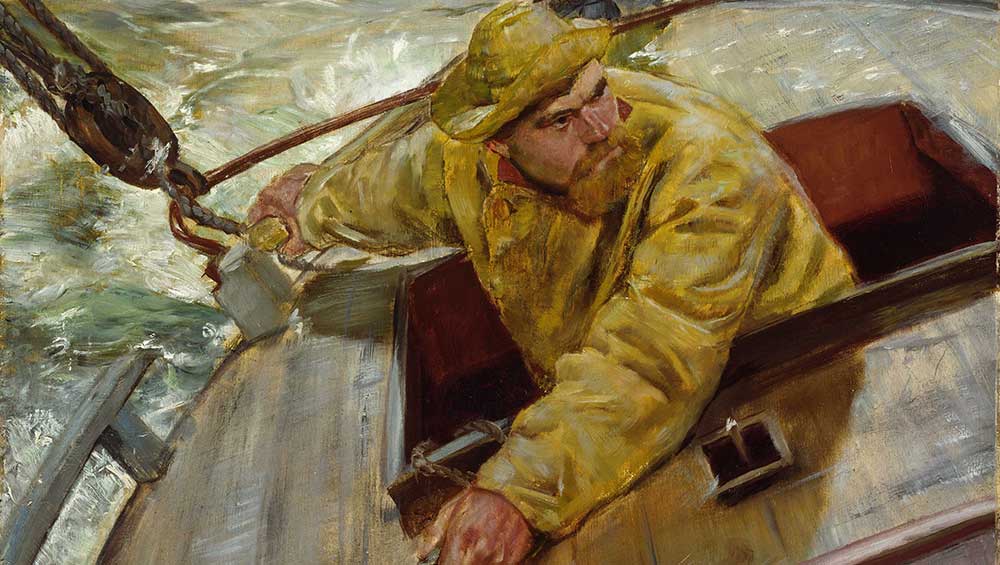
Christian Krohg. La Barre sous le vent! (The Leeward Bar!), 1882 (detail). Oil on canvas, 50 × 60 cm. Oslo National Museum. Photo: © Nasjonalmuseet / Jaques Lathion.
Musée d’Orsay, Paris
25 March – 27 July 2025
by SABINE SCHERECK
Out on the stormy sea, the small wooden boat is on a slant, fighting against the gusting wind; the fisherman’s body is tensed, steering the boat through the rough water, one hand firmly on the tiller, the other pulling on a rope, his eyes fixed on a point in the distance. You can almost hear the waves crashing against the storm-tossed vessel. The image could easily be a shot from a Hollywood action movie, but it is not. It is Christian Krohg’s painting La Barre Sous le Vent! (1882), which has such a powerful dynamic that it draws the viewer right into the scene. It is no surprise that this image has become the face of the exhibition at the Musée d’Orsay in Paris, used on the posters and the cover of the catalogue.
The exhibition concludes a trilogy featuring Norwegian artists from the turn of the 20th century. It began with Edvard Munch: A Poem of Life, Love and Death in 2022 and was followed by Harriet Backer: The Music of Colours in 2024. Backer was a stunning discovery for those outside Norway. With her exquisite way of capturing light, she produced such atmospheric paintings that it was an absolute joy to see the exhibition. She is a stunning artist who will now hopefully get more exposure.
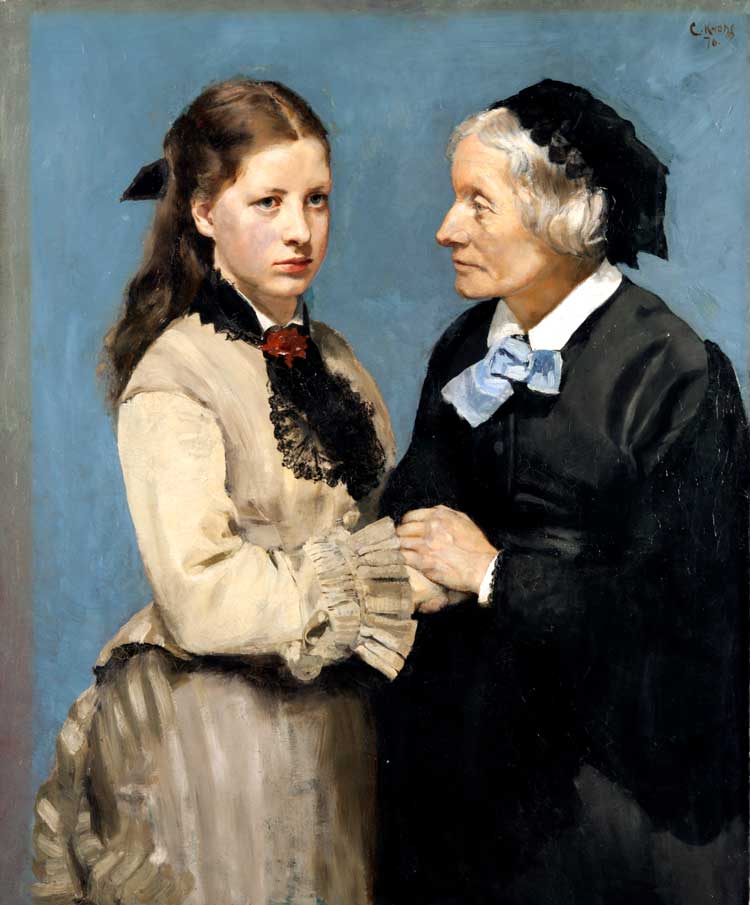
Christian Krohg. A Farewell, 1876. Oil on canvas, 100.5 × 83 cm. Göteborg, Göteborgs Konstmuseum. Photo: © Gothenburg Museum of Art / Hossein Sehatlou.
Krohg (1852-1925) is not a complete stranger. He is firmly established in Norway’s art history and his strong depictions of life determined by the sea make him a name to remember – as I discovered when I encountered him as part of the exhibition Between Storm and Stillness, at the International Maritime Museum Hamburg last year. However, this show is the first retrospective of his work outside Scandinavia. The title, The People of the North, is well chosen as it presents an array of characters whose calm, sober and unflappable presence offer an insight into the northern sentiment. The introduction to Krohg shows his painting A Farewell (1876), portraying an elderly lady holding the hands of a younger woman while looking at her with a gentle but firm expression. A grandmother saying “Take good care of yourself, my child” comes to mind. The young woman gazes with a sense of detachment into the distance. The picture was Krohg’s breakthrough, and its captivating power can still be felt. The soft lighting on their faces coming from above is remarkable, as if in a photographer’s studio, removing them even further from the plain dove-blue background. Nothing distracts from the awkward moment between these two women.
Krohg was born in Oslo (then known as Christiania and later Kristiania) into a middle-class family and, at 22, left to study art in Karlsruhe, Germany, before changing to the Prussian Academy of Arts in Berlin. Unhappy in this city, he sought artistic fulfilment by joining fellow Nordic painters at an artists’ colony in Skagen, Denmark. There his output reached unparalleled heights when he was drawn into the life of the local fishermen.
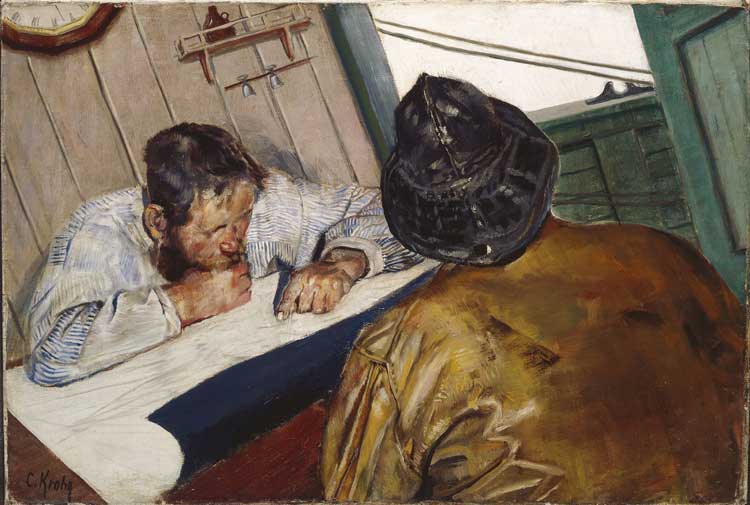
Christian Krohg. The Project Is Studied, 1910. Oil on canvas, 45 × 66 cm. Lillehammer, Lillehammer Kunstmuseum. Photo: © Jacques Lathion, Lillehammer Art Museum.
During this period, he produced vivid cinematic images, taking the viewer on board at the fishermen’s side to witness the danger and drama of their work at sea. At the same time, the pictures drew attention to how fragile life at sea was and the physical and mental strength required to get through these rough periods. In Fixing the Sail (date unknown), a fisherman is dangling over a spar, looking as if the next gust of wind might push him off, his coat and the indistinct washed grey-blue background with a touch of light brown suggesting hostile weather. In The Project Is Studied (1910), a young man sits inspecting a map at a table inside a boat, while opposite him a man in an oilskin and sou’wester, with his back to the viewer, seems to wait for an answer. Everything is on a slant evoking a rocking boat. Next to this is the large painting Man Overboard (1906). With its bold perspective, the viewer looks, as if from above, at the back of a man rushing upwards out of the frame, holding behind him a white luminous ring that he is about to hurl into the water. The drama and tension of the image is inescapable.
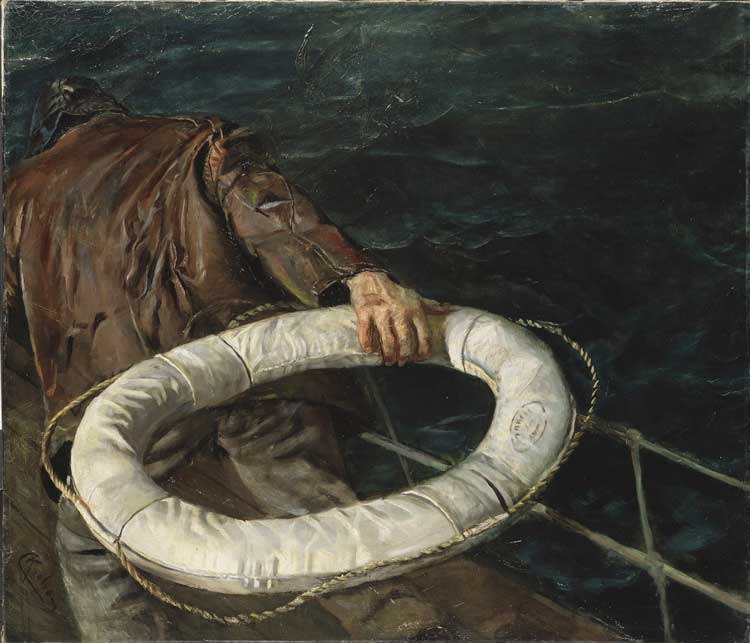
Christian Krohg. Man Overboard, 1906. Oil on canvas, 120 × 140 cm. Stockholm, Nationalmuseum. Photo: © Nationalmuseum.
The cinematic quality of Krohg’s work gives the images a modern edge, which is heightened by Servane Dargnies-de Vitry and Vibeke Waallann Hansen’s curatorship. By placing these images side by side, they have turned them into something akin to the storyboard of a film where snapshots catch what is happening simultaneously at different locations and thus feed into the narration. Krohg’s portrayal of the hardship faced by men at sea was important to him: his humanist outlook and commitment to social change was fostered by having experienced their lives at close quarters and his realist depiction of their work was a first step into that direction.
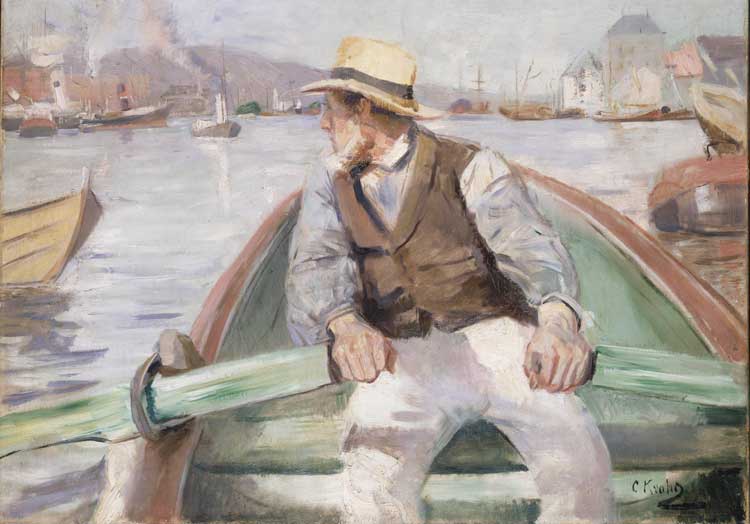
Christian Krohg. Look Ahead, Bergen Harbour, 1884. Oil on canvas, 62.5 x 86 cm. Oslo National Museum. Photo: © Nasjonalmuseet / Jacques Lathion.
Krohg returned to Skagen several times. In between, he travelled to France to hone his craft by observing the latest artistic trends, in this case impressionism. Gustave Courbet, Gustave Caillebotte and Édouard Manet greatly influenced him in terms of creating the immediacy of a scene, composition and perspective. An example of this is Krohg’s Look Ahead, Bergen Harbour (1884), which closely resembles Caillebotte’s Oarsman in a Top Hat (1876). Also, Krohg’s later works show traces of impressionism with regards to the style, which fusses less over details. This is particularly evident in Portrait of the Painter Gerhard Munthe (1885), which is set in a dingy cafe and could easily be mistaken for a Frenchman’s work. The work is part of the following section of the exhibition featuring portraits, and transports the visitor back to Norway where Krohg resettled in 1882 and engaged in social debates.
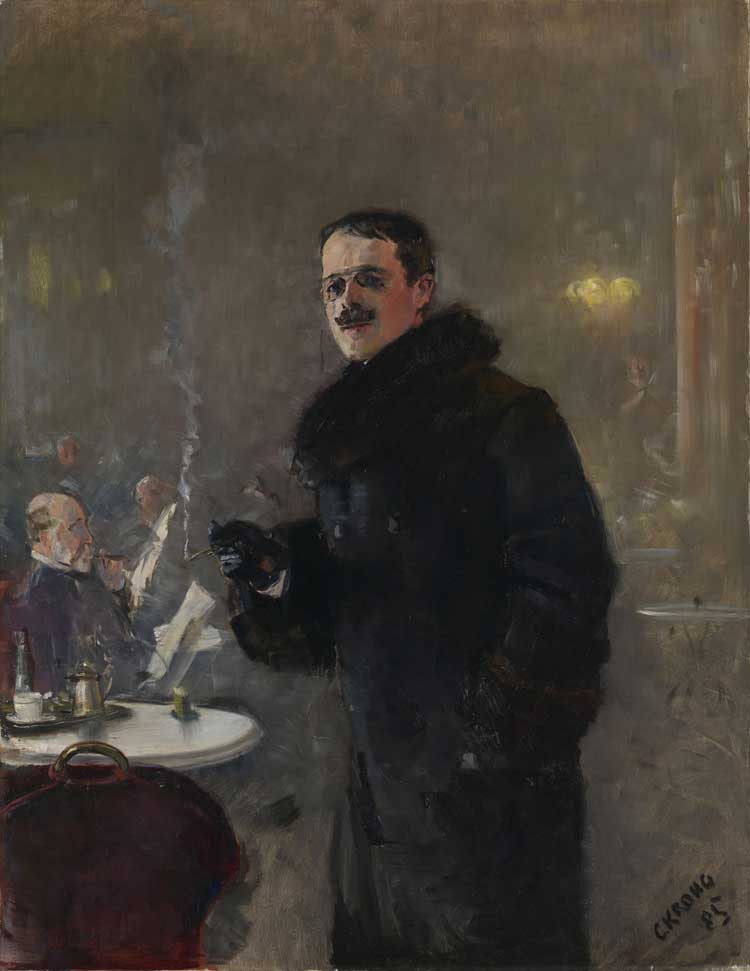
Christian Krohg. Portrait of the Painter Gerhard Munthe, 1885. Oil on canvas, 150 × 115 cm. Oslo National Museum. Photo: © Nasjonalmuseet / Børre Høstland.
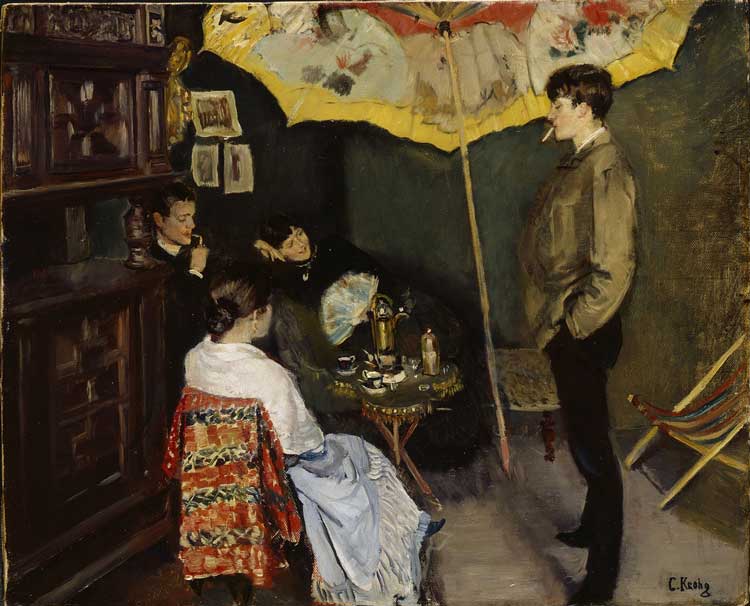
Christian Krohg. The Bohemians (In my studio), 1885. Oil on canvas, 56 × 67 cm. Lillehammer, Lillehammer Kunstmuseum. Photo: © Jacques Lathion, Lillehammer Art Museum.
He was part of “Kristiana Bohemia”, a small circle of artists and intellectuals who produced the newspaper Impressionisten (The Impressionist). Unlike the art movement, the publication aimed at a naturalist portrayal of work, poverty and injustice – albeit by way of snapshots championed by impressionism. Krohg also wrote for the newspaper, which advocated social change, and the works in this room of the exhibition primarily show his paintings of his fellow bohemians with whom he shared a similar mindset. Being surrounded by them gives the viewer a sense of being at one of their gatherings. They are mostly men and among them is a portrait of the Norwegian newspaper editor Ola Thommessen (1884), a close friend of Krohg. It captures him as a pensive, melancholic young man looking slightly downwards. There is also a portrait of the young Danish literary critic Georg Brandes (1879), who promoted modern ideas in Scandinavia and had a great influence on Krohg. For nine months, Brandes sat every morning for this painting and the bond formed between the pair is felt in his look.
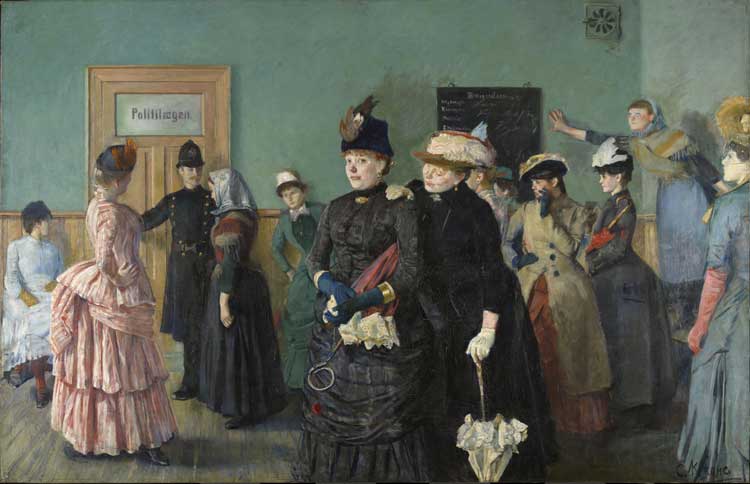
Christian Krohg. Albertine in the Police Doctor’s Waiting-Room, 1885-87. Oil on canvas, 210 x 325,4 cm. Oslo National Museum. Photo: © Nasjonalmuseet / Børre Høstland.
Krohg’s writings and paintings position him in the “modern breakthrough” or Scandinavian realism movement. The theme of changing society through art is picked up in the following room, where his works on the subject are displayed. An example of this is his novel Albertine, which provoked a scandal and was confiscated by the police. It tells the story of a seamstress raped by a police officer and subsequently forced into prostitution by social circumstances. The book was accompanied by a series of paintings, including – also on show here – Albertine in the Police Doctor’s Waiting-Room (1887), a monumental piece that was equally controversial. There are also touching portraits of seamstresses asleep at a table by the window, where a lamp is still burning although daylight is already entering the room. They had clearly been working until the point of exhaustion. A central piece in this section is Struggle for Existence (1889), depicting a wintery street in Oslo, where a cluster of poverty-stricken children and women reach for an old loaf that a baker is holding out of a window. It is a scene that could be straight out of a Charles Dickens novel.
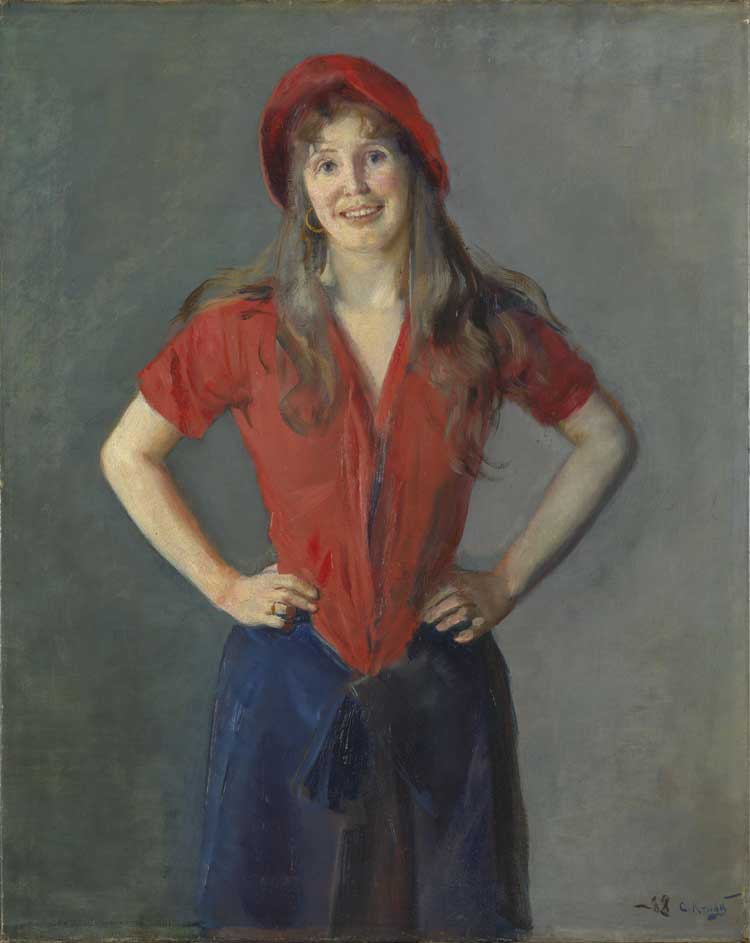
Christian Krohg. Portrait of the painter Oda Krohg, 1888. Oil on canvas, 86,4 x 68.8 cm. Oslo National Museum. Photo: © Nasjonalmuseet / Børre Høstland.
The final room takes the visitor to Krohg’s family home. He had married Oda Lasson, a former student, in 1888. Long before they tied the knot, they defied social conventions by having an open relationship and a child born out of wedlock. The intimate pictures at home show another side – not only of him, but also of her. In Krohg’s portrait of her displayed in a previous section, Oda is shown as a good-natured, strong and emancipated woman, who could stand her ground. The intimate family pictures at home show another side, in which she is presented as a caring parent. In East of the Sun and West of the Moon (before 1887), Oda is reading a bedtime story to her two children. In the Morning (1889) shows her lying in bed breastfeeding her newborn. The soft bright light and white bed linen capture a peaceful moment.
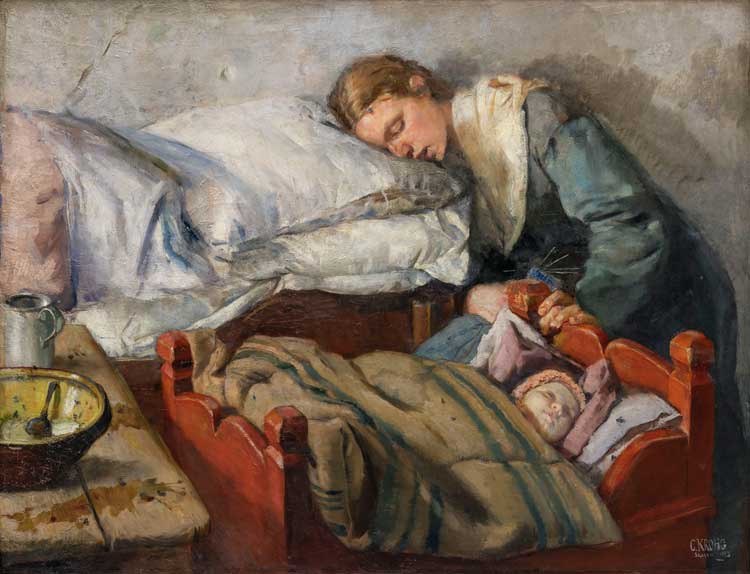
Christian Krohg. The Sleeping Mother, 1883. Oil on canvas, 107.5 × 142 cm. Bergen, Kode Bergen Art Museum. Photo: © Kode / Dag Fosse.
These intimate portraits are in stark contrast to the stiff A Farewell and the dramatic scenes at sea featured at the beginning of the show. The exhibition presents a fine portrait of Krohg by creating a well thought through journey from the harshness of the outside world to the comfort of his home.
Being the final chapter focusing on Norwegian art, the exhibition also reveals a narrative arc within this trilogy. Having started with Munch and his groundbreaking expressionist work, it touched on the preceding art movement by illuminating the brilliant impressionist Backer, before reaching further back into art history and delving into realism by way of Krohg. Through him the trilogy also comes full circle because Munch was one of his pupils. However, while the trilogy traces a stylistic development within art history, the dates of the works by these three artists show that these styles were being practised simultaneously. Overall, this trilogy has been a fascinating exploration of Norwegian art and the Nordic world, which are rarely put into the spotlight.